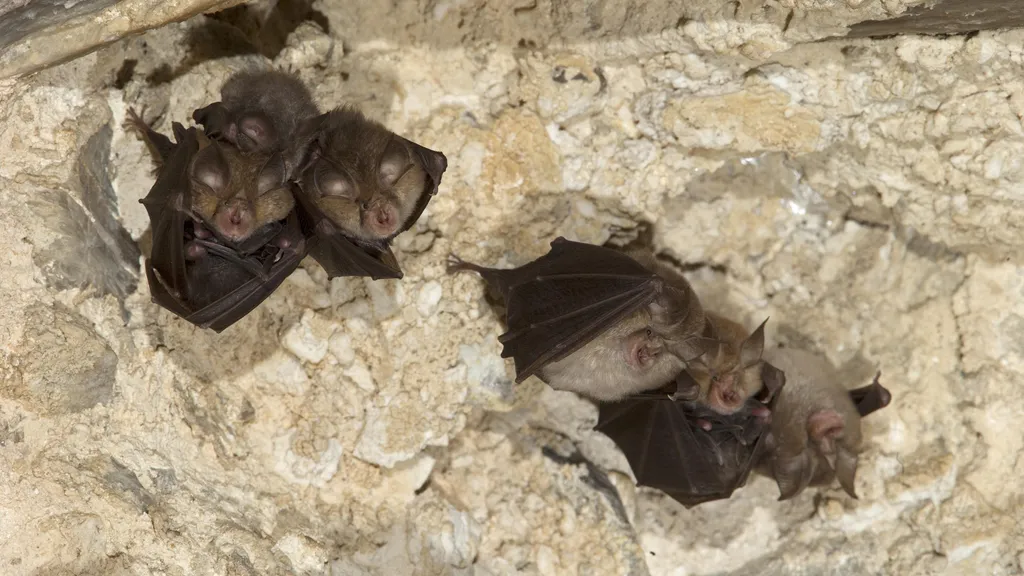라오스 박쥐에서 발견된
바이러스는
사스-CoV-2와
가장 가까운 친척으로
알려진다.
By Rachael Rettner about 22 hours ago
약 22시간 전 -
레이철 레트너
Strengthening case for natural origin.
자연적 유래를 강화해주는 케이스.

(Image credit: BROKER/Franz Christoph Robiller via Getty Images)
(사진 제공:
게티 이미지를 통한
브로커/
프란츠 크리스토프 로비러)
Researchers have discovered coronaviruses lurking in Laotian bats that appear to be the closest known relatives to SARS-CoV-2, the virus that causes COVID-19, found to date, according to news reports.
뉴스 보도에 따르면
연구원들이
라오스 박쥐에 숨어 있는
코로나바이러스를 발견했는데,
이 바이러스는
현재까지
COVID-19를 일으키는 바이러스인
사스-CoV-2와
가장 가까운 친척으로
알려진 것으로 보인다.
In a new study, researchers from the Pasteur Institute in France and the University of Laos captured 645 bats from limestone caves in northern Laos and screened them for viruses related to SARS-CoV-2. They found three viruses — which they dubbed BANAL-52, BANAL-103 and BANAL-236 — that infected horseshoe bats and shared more than 95% of their overall genome with SARS-CoV-2.
새로운 연구에서,
프랑스의 파스퇴르 연구소와 라오스 대학의
연구원들은
북부 라오스의 석회암 동굴에서
645마리의 박쥐를 포획하여
사스-CoV-2와 관련된 바이러스들을
검사했다.
그들은 관박쥐를 감염시키고
전체 게놈의 95% 이상을
사스-CoV-2와 공유하는
BANAL-52, BANAL-103 그리고
BANAL-236라고 별명이 붙은
세 가지 바이러스를 발견했다.
One of the viruses, BANAL-52, was 96.8% identical to SARS-CoV-2, according to Nature News. That makes BANAL-52 more genetically similar to SARS-CoV-2 than any other known virus. Previously, the closest known relative to SARS-CoV-2 was RaTG13, which was found in horseshoe bats in 2013 and shares 96.1% of its genome with SARS-CoV-2, Nature News reported.
네이처 뉴스에 따르면
바이러스 중 하나인 BANAL-52는
사스-CoV-2와 96.8% 동일했다.
이로 인해
BANAL-52는 다른 알려진 바이러스보다
유전적으로 사스-CoV-2와 더 유사하다.
이전에,
사스-CoV-2와 가장 가까운 것으로 알려진
RaTG13은 관박쥐에서 2013년에 발견되었고
그것의 게놈의 96.1%를 사스-CoV-2와 공유한다고
네이처 뉴스가 보도했다.
Related: 7 facts about the origin of the novel coronavirus
관련항목:
신종 코로나바이러스의
기원에 관한
7가지 사실
What's more, all three of the newly discovered viruses are more similar to SARS-CoV-2 in a key part of their genome — called the receptor binding domain (RBD) — than other known viruses. The RBD is the part of the virus that allows it to bind to host cells. With SARS-CoV-2, the RBD binds to a receptor known as ACE2 on human cells, and the virus uses this receptor as a gateway into cells.
게다가,
새로 발견된 세 가지 바이러스 모두
알려진 다른 바이러스들보다 —
수용체 결합 도메인 (RBD)이라고 불리는 —
그들 게놈의 핵심 부분에서
사스-CoV-2와 더 유사하다.
RBD는
숙주 세포에 결합할 수 있게 해주는
바이러스의 일부이다.
사스-CoV-2와 함께,
RBD는 인간 세포에서
ACE2로 알려진 수용체와 결합하고,
바이러스는
이 수용체를
세포로 가는 관문으로 사용한다.
Critically, the new study found that BANAL-52, BANAL-103 and BANAL-236 can bind to ACE2 and use it to enter human cells. So far, other candidates proposed as ancestors of SARS-CoV-2 found in bats, including RaTG13, haven't been able to do this, the researchers said. The three viruses could bind to ACE2 about as well as early strains of SARS-CoV-2 found in Wuhan, they said.
비판적으로,
이 새로운 연구는
BANAL-52, BANAL-103, 그리고 BANAL-236이
ACE2에 결합할 수 있고
그것을 인간의 세포로 들어가는 데
사용할 수 있다는 것을 발견했다.
지금까지,
RaTG13을 포함하여
박쥐에서 발견된 사스-CoV-2의
조상으로 제안된 다른 후보군은
이것을 할 수 없었다고
연구원들은 말했다.
이 세 가지 바이러스는
ACE2뿐만 아니라
우한에서 발견된 초기 사스-CoV-2 변종과도
결합할 수 있다고 그들은 말했다.
The findings, which were posted to the preprint server Research Square on Sept. 17, add to the evidence that SARS-CoV-2 had a natural origin, rather than escaping from a lab.
9월 17일 인쇄 전 서버인
연구 영역에 게재된
이 연구결과는
사스-CoV-2가
실험실에서 탈출하는 것이 아니라
자연적으로 발생했다는 증거를
더해주고 있다.
The results show "that sequences very close to those of the early strains of SARS-CoV-2 ... exist in nature," the researchers wrote in their paper, which has yet to be peer-reviewed.
그 결과는
"사스-CoV-2의 초기 변종들과
매우 가깝다는 결론과...
자연적으로 존재한다는 것"
을 보여준다, 라고 연구진은
논문에 썼으나, 그런데 이 논문은
아직 동료 검토가 이루어지지 않았다.
Originally published on Live Science.
라이브 사이언스에 원본으로 발간됨.

댓글 없음:
댓글 쓰기